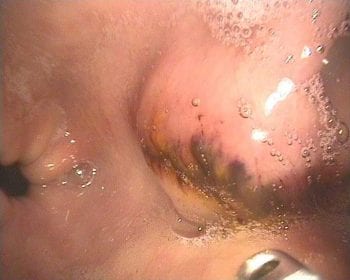6 Dec 2018
A well-documented condition affecting young and adult horses, less is known about equine gastric ulceration syndrome and its pathogenesis in the foal. Lars Lerche Mortensen offers advice on the diagnosis, treatment and prevention of this condition.

Less is known about this condition and its pathogenesis in the foal than in adult horses.
As the year draws to an end and with Christmas and New Year quickly approaching, many vets up and down the country are preparing for yet another busy and rewarding breeding season. With this in mind, now seems like a good time to focus on one of the many conditions that may affect the foal – gastric ulceration.
Equine gastric ulceration syndrome (EGUS) is a well-documented condition affecting young and adult horses, and thanks to veterinary research and practical experience our understanding and treatment of this syndrome has improved rapidly in the past few years.

However, less is known about this condition and its pathogenesis in the foal than in adult horses. It has been estimated that as many as 50% of foals will suffer from gastric ulceration within the first few months of their life1 and one study found gastric lesions in 22% of foals prior to weaning with the incidence increasing to 98% two weeks after weaning3.
Foals are born with a gastric pH of >4.0 and by one week of age this will have decreased to <2.02. Under normal circumstances, a healthy foal will nurse from its mother 7-10 times an hour. The continued presence and supply of fresh milk as well as bicarbonate in the saliva, which is produced and swallowed at the time of feeds, further helps to neutralise the stomach acid2. Therefore, anything which disturbs this natural intake of milk can leave foals with periods of high acidity within their stomach, increasing the potential for gastric ulceration. Risk factors for this may include:
Stress plays an important role in predilection for ulcers, especially in older foals. It leads to the release of cortisol which reduces production of natural protective compounds, prostaglandins. The lack of prostaglandins in turn leads to a fall in the gastric mucous production which protects the stomach lining, as well as decreasing the release of gastric bicarbonate buffer.
The most common clinical signs include anorexia, teeth grinding, salivation, diarrhoea, dorsal recumbency and other signs of colic2, however as many as 57% of foals may be asymptomatic3.

The majority of foals suspected or diagnosed with gastric ulceration are more than two days old with a high risk at the time of weaning. However, one case has been reported of a 24-hour-old colt foal which presented with clinical signs (dorsal recumbency) consistent with gastric ulceration2. Upon further investigation the foal was found to have an ulcer in the squamous region and the foal was successfully treated with omeprazole paste2.
Post mortem studies of aborted foetuses have shown no evidence of gastric ulcers, indicating that gastric ulceration in foals may not be a result of physiological stress during pregnancy2. It is therefore likely that gastric ulcers in foals develop after birth.
Severe consequences of ulcers within the stomach can include delayed gastric emptying, gastroesophageal reflux and esophagitis.
As a foal’s stomach lining is comparably thinner than that of an adult horse, foals are also at greater risk of gastric ulcers causing gastric perforation and peritonitis leading to foals having a higher fatality rate from gastric ulcers than adult horses.
Ulcers within the proximal part of the small intestine can lead to permanent scarring which can cause issues with onward flow of ingesta from the stomach, as well as compromising nutritional digestion and absorption.
Although gastric ulceration can be suspected due to clinical signs and history, the gold standard diagnosis is by gastroscopy. More recently researchers have investigated a screening test based on the analysis of blood sucrose, with promising results. This test may prove useful in selecting candidates for gastroscopy leading to earlier diagnosis in weanling foals3.
The most important part of treating a foal is to remove the initiating cause of ulceration if known. Therefore identifying and reducing risk factors are key to the successful treatment of gastric ulcers in foals. For example, ensure regular nursing, remove any causes of stress and treat any underlying illness appropriately.

Anti-ulcer medications, such as omeprazole, have been demonstrated to be an effective treatment in most cases, with foals showing improvements quite rapidly over a period of two to three days.
Omeprazole formulations are licenced for use in foals from four weeks of age in the UK.
The key in helping to prevent ulceration is good foal husbandry to reduce stress levels alongside ensuring a frequent and adequate access to feed. Either by ensuring a foal is nursing correctly, or in case of older foals, encouraging appropriate levels of nutrition through access to grass or additional creep feeding.
Gradual weaning is recommended so that an abrupt change in diet and behaviour does not occur thereby reducing the stress experienced over the high-risk weaning period. Heavy reliance on grain based diets or concentrates should be avoided as these promote an acidic stomach environment, something we look to avoid as much as possible during this transition period.
Treatment is aimed to be a short term measure, while prevention should form the mainstay of continuation therapy.